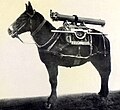Mountain gun
| 76 mm Mountain Gun M1909 |
|---|
 Russian Model 1909 mountain gun |
| Type | Mountain gun |
|---|
| Place of origin | France |
|---|
|
| Used by | See users |
|---|
| Wars | World War I, Russian Civil War, Finnish Civil War, Soviet-Polish War, Winter War, World War II |
|---|
|
| Designer | Panagiotis Danglis |
|---|
| Manufacturer | Schneider-Creusot
Putilov Plant |
|---|
| Produced | 1909-1938 |
|---|
| No. built | 2,060 |
|---|
| Variants | See variants |
|---|
|
| Mass | Transport: 1,225 kg (2,701 lbs)
Combat: 627 kg (1,382 lbs) |
|---|
| Barrel length | 1.25 m (4 ft 1 in) L/16.5[1] |
|---|
| Width | 1 m (3 ft 3 in) |
|---|
| Height | 1.3 m (4 ft 3 in) |
|---|
| Crew | 6 |
|---|
|
| Shell | Fixed quick-fire 76.2 × 191 mm R |
|---|
| Shell weight | 6.23 kg (13 lb 12 oz) |
|---|
| Caliber | 76.2 mm (3 in) |
|---|
| Breech | Interrupted screw |
|---|
| Recoil | Hydro-pneumatic |
|---|
| Carriage | Box trail |
|---|
| Elevation | -6° to +28° |
|---|
| Traverse | 5° |
|---|
| Rate of fire | 10 rpm |
|---|
| Muzzle velocity | 387 m/s (1,270 ft/s) |
|---|
| Maximum firing range | 8,550 m (9,350 yds)[1] |
|---|
The 76 mm Mountain Gun Model 1909 (Russian 76-мм горная пушка образца 1909 года, 3-дюймовая пушка системы Шнеидера) was a rapid-fire mountain gun based on the Schneider-Danglis mountain gun that was used by the Imperial Russian Army during World War I and the Red Army during World War II
History
In 1893, the Greek engineer Colonel Panagiotis Danglis developed a design for a 75 mm mountain cannon and submitted it to the Greek Ministry of War. However, he would have to wait ten years before his project was authorized. In 1905, Danglis proposed to the French firm Schneider that a prototype of his gun should be entered in the next competition for the Greek Army. Schneider developed its own carriage for the gun and the revised design was known as the Schneider-Danglis mountain gun. The prototype was tested in France in May 1906 and in April the gun was tested in Greece, after which the gun was adopted for service by the Greek Army. Early in 1909, the Schneider company had produced enough guns to arm six batteries.[2]
Design
The 76 mm Mountain Gun Model 1909 was a breech-loaded howitzer made of steel with an interrupted screw breech and used fixed quick-fire ammunition. It had a box trail carriage, gun shield, two wooden-spoked steel-rimmed wheels, and a hydro-pneumatic recoil mechanism. For transport, the gun could be dismantled into seven mule loads or hooked to a limber and caisson for towing by a horse team when assembled.
Imperial Russian Army
At the beginning of 1908, a Schneider-Danglis gun was demonstrated to the inspector general of artillery of the Imperial Russian Army, Grand Duke Sergei Mikhailovich. At his request, Nicholas II instructed the army to perform competitive tests of rapid-fire mountain guns from Schneider and the Škoda Works. Two guns from Schneider and Škoda were tested by the army in December 1908. An advantage of the Škoda system was its lower weight that made it easier to transport. While the Schneider-Danglis cannon had better ballistics and a reliable hydro-pneumatic recoil mechanism instead of the Škoda spring recoil system.[3]
As a result of the tests, the Artillery Committee obtained a production license from Schneider. On February 25, 1909, the Artillery Committee requested the adoption of the gun to Emperor Nicholas II which he authorized on February 26. Based on the test results, it was decided to replace the original wheels and the sight of the Schneider company with Okhremenko wheels and Hertz panoramic sights produced by the Obukhov Plant. The new gun would also use 76.2 × 191 mm R fixed quick-fire ammunition. Tests revealed that only the ammunition packs met the stipulated 100 kg (220 lb) weight and the rest of the packs weighed from 120–140 kg (260–310 lb) which was too heavy for Russian packhorses. The joints of the carriage also wobbled and rattled while being towed.[2]
Production
It is believed 2,060 M1909s were produced between 1909-1938. On January 1, 1912, all 214 guns of the first order from the Putilov Plant were delivered. Between 1911-1916, the Putilov Plant received orders for another 772 guns. By June 20, 1917, the Putilov Plant had delivered 636 guns from these orders. Another 349 guns were built between 1914-1917, at the St. Petersburg Gun Factory.[2]
Production of the M1909 resumed during the 1920s at plant No. 8 (St. Petersburg Gun Factory, evacuated in 1918 to the village of Podlipki). Between 1924 and 1931, 110 guns were produced there. After that, production was transferred to plant No. 92 (Novoye Sormovo). No guns were produced at plant No. 92 during 1932, 1934, and 1936.
| 1933
|
1935
|
1937
|
1938
|
1939
|
Total
|
| 21
|
20
|
40
|
305
|
250
|
636
|











